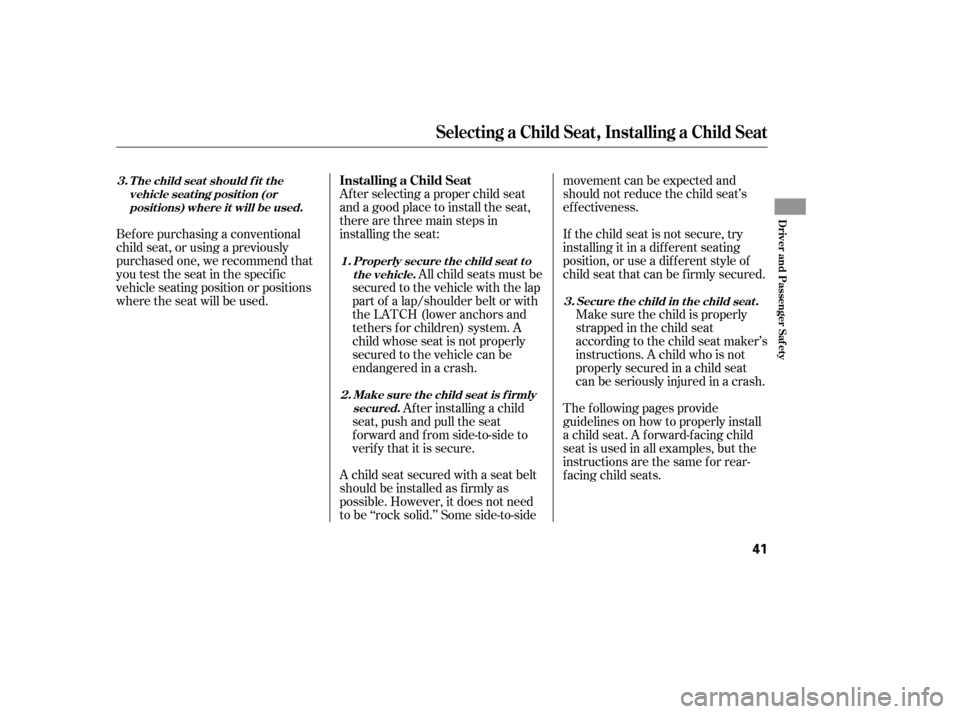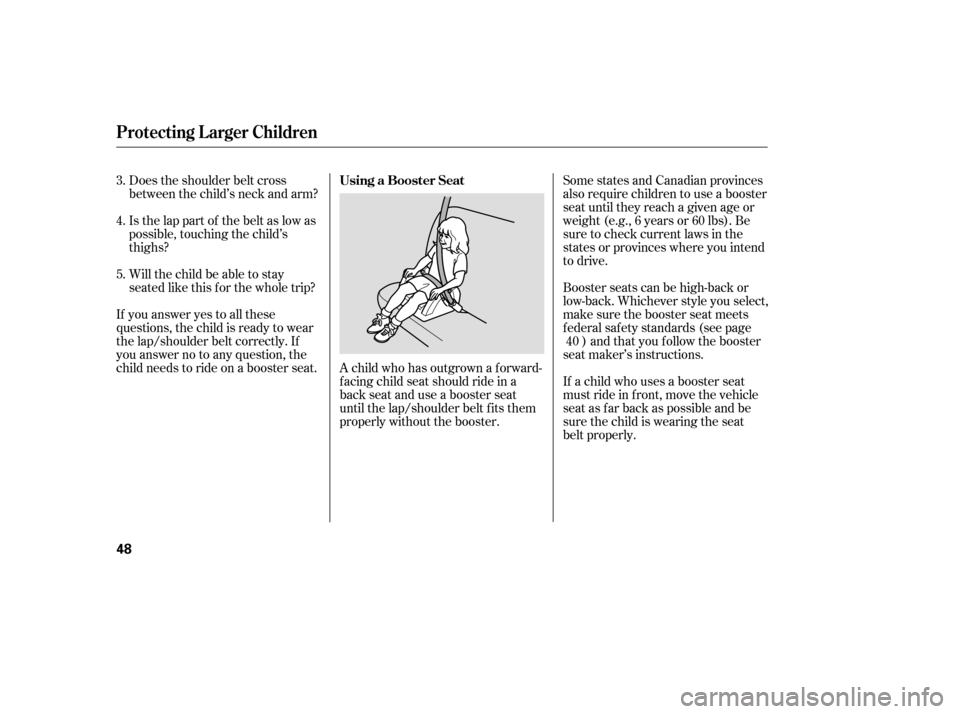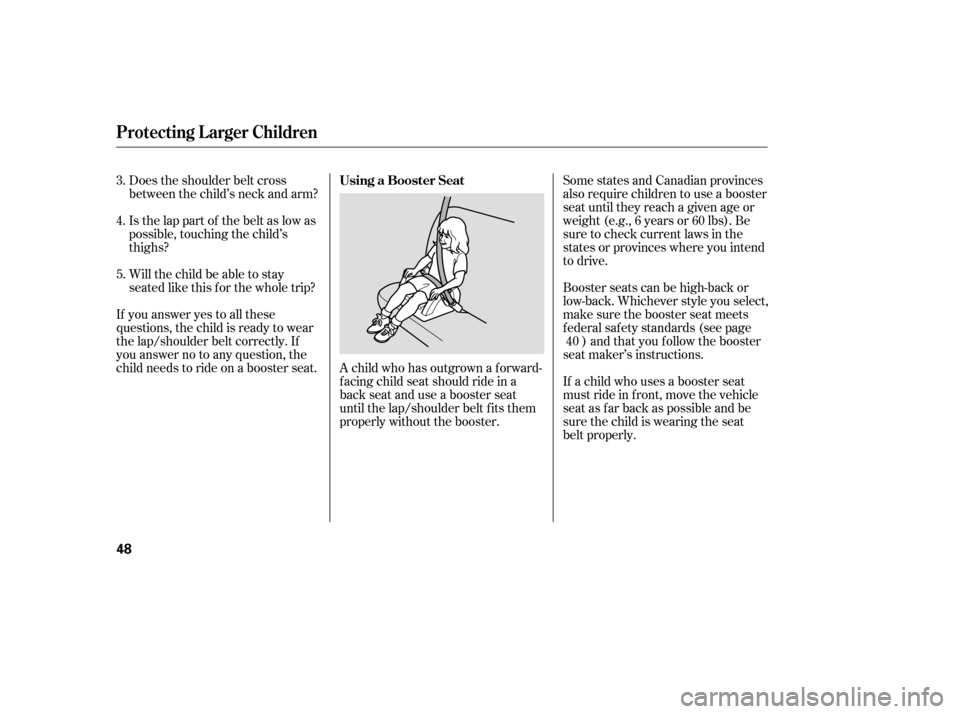Page 53 of 436

Af ter selecting a proper child seat
and a good place to install the seat,
there are three main steps in
installing the seat:All child seats must be
secured to the vehicle with the lap
part of a lap/shoulder belt or with
the LATCH (lower anchors and
tethers for children) system. A
child whose seat is not properly
secured to the vehicle can be
endangered in a crash.
Af ter installing a child
seat, push and pull the seat
f orward and f rom side-to-side to
verif y that it is secure.
A child seat secured with a seat belt
should be installed as f irmly as
possible. However, it does not need
to be ‘‘rock solid.’’ Some side-to-side movement can be expected and
should not reduce the child seat’s
ef f ectiveness.
If the child seat is not secure, try
installing it in a dif f erent seating
position, or use a dif f erent style of
child seat that can be f irmly secured.
Bef ore purchasing a conventional
child seat, or using a previously
purchased one, we recommend that
you test the seat in the specif ic
vehicle seating position or positions
where the seat will be used.
Make sure the child is properly
strappedinthechildseat
according to the child seat maker’s
instructions. A child who is not
properly secured in a child seat
can be seriously injured in a crash.
The f ollowing pages provide
guidelines on how to properly install
a child seat. A f orward-f acing child
seat is used in all examples, but the
instructions are the same f or rear-
f acing child seats.
Installing a Child Seat
Properly secure t he child seat t o
the vehicle.
Make sure t he child seat is f irmlysecured.
T he child seat should f it the
vehicle seat ing posit ion (orposit ions) where it will be used.
Secure the child in the child seat.
3.
1.
2. 3.
Selecting a Child Seat, Installing a Child Seat
Driver and Passenger Saf ety
41
�����—�����—�����y�
���������
���y���
�)�������
���y���������y
Page 54 of 436

Af ter selecting a proper child seat
and a good place to install the seat,
there are three main steps in
installing the seat:All child seats must be
secured to the vehicle with the lap
part of a lap/shoulder belt or with
the LATCH (lower anchors and
tethers for children) system. A
child whose seat is not properly
secured to the vehicle can be
endangered in a crash.
Af ter installing a child
seat, push and pull the seat
f orward and f rom side-to-side to
verif y that it is secure.
A child seat secured with a seat belt
should be installed as f irmly as
possible. However, it does not need
to be ‘‘rock solid.’’ Some side-to-side movement can be expected and
should not reduce the child seat’s
ef f ectiveness.
If the child seat is not secure, try
installing it in a dif f erent seating
position, or use a dif f erent style of
child seat that can be f irmly secured.
Bef ore purchasing a conventional
child seat, or using a previously
purchased one, we recommend that
you test the seat in the specif ic
vehicle seating position or positions
where the seat will be used.
Make sure the child is properly
strappedinthechildseat
according to the child seat maker’s
instructions. A child who is not
properly secured in a child seat
can be seriously injured in a crash.
The f ollowing pages provide
guidelines on how to properly install
a child seat. A f orward-f acing child
seat is used in all examples, but the
instructions are the same f or rear-
f acing child seats.
Installing a Child Seat
Properly secure t he child seat t o
the vehicle.
Make sure t he child seat is f irmlysecured.
T he child seat should f it the
vehicle seat ing posit ion (orposit ions) where it will be used.
Secure the child in the child seat.
3.
1.
2. 3.
Selecting a Child Seat, Installing a Child Seat
Driver and Passenger Saf ety
41
�����—�����—�����y�
���������
���y���
�)�������
���y���������y
Page 55 of 436
Make sure there are no objects
near the anchors that could
prevent a secure connection
between the child seat and the
anchors.
Move the seat belt buckle or
tongue away f rom the lower
anchors.
To install a LATCH-compatible child
seat:
Place the child seat on the vehicle
seat, then attach the seat to the
lower anchors according to the
child seat maker’s instructions.
Your vehicle is equipped with
LATCH (lower anchors and tethers
for children) at the outer rear seats.
The lower anchors are located
between the seat-back and seat
bottom, and are to be used only with
a child seat designed f or use with
LATCH.
The location of each lower anchor is
indicated by a small button above the
anchor point.
Some LATCH-compatible seats
have a rigid-type connector as
shown above.
1. 2. 3.
Installing a Child Seat with
LATCH
Installing a Child Seat
42
BUTTON
Rigid type
LOWER ANCHORS
�����—�����—�����y�
�������������y���
�)�������
���y���������y
Page 56 of 436
Whatever type you have, f ollow
the child seat maker’s instructions
f or adjusting or tightening the f it.Push and pull the child seat
f orward and f rom side-to-side to
verif y that it is secure.
Other LATCH-compatible seats
have a f lexible-type connector as
shown above. Lif t the head restraint (see page
), then route the tether strap
through the legs of the head
restraint and over the seat-back,
making sure the strap is not
twisted.
Attach the tether strap hook to the
tether anchor, then tighten the
strap as instructed by the child
seat maker.
4.
5. 6.7.
95
Installing a Child Seat
Driver and Passenger Saf ety
43
TETHER
STRAP HOOK ANCHOR
Flexible type
�����—�����—�����y�
�����������
�y���
�)�������
���y���������y
Page 57 of 436
When not using the LATCH system,
all child seats must be secured to the
vehicle with the lap part of a lap/
shoulder belt.With the child seat in the desired
seating position, route the belt
through the child seat according
to the seat maker’s instructions,
then insert the latch plate into the
buckle.To activate the lockable retractor,
slowly pull the shoulder part of the
belt all the way out until it stops,
then let the belt f eed back into the
retractor.
Af ter the belt has retracted, tug on
it. If the belt is locked, you will not
be able to pull it out. If you can pull
thebeltout,itisnotlocked,and
you will need to repeat these steps.
In addition, the lap/shoulder belts in
all seating positions except the
driver’s have a lockable retractor
that must be activated to secure a
child seat.
1.2. 3.
Installing a Child Seat with a L ap/
Shoulder Belt
Installing a Child Seat
44
�����—�����—�����y�
�������������y���
�)�������
���y���������y
Page 61 of 436

Does the shoulder belt cross
between the child’s neck and arm?
Is the lap part of the belt as low as
possible, touching the child’s
thighs?
Will the child be able to stay
seated like this f or the whole trip?
If you answer yes to all these
questions, the child is ready to wear
the lap/shoulder belt correctly. If
you answer no to any question, the
child needs to ride on a booster seat. A child who has outgrown a f orward- f acing child seat should ride in a
back seat and use a booster seat
until the lap/shoulder belt f its them
properly without the booster.Some states and Canadian provinces
also require children to use a booster
seat until they reach a given age or
weight (e.g., 6 years or 60 lbs). Be
sure to check current laws in the
states or provinces where you intend
to drive.
Booster seats can be high-back or
low-back. Whichever style you select,
make sure the booster seat meets
f ederal saf ety standards (see page
) and that you f ollow the booster
seat maker’s instructions.
If a child who uses a booster seat
must ride in f ront, move the vehicle
seat as far back as possible and be
sure the child is wearing the seat
belt properly.
4. 5.
3.
40
Using a Booster Seat
Protecting L arger Children
48
�����—�����—�����y�
���������
���y���
�)�������
���y���������y
Page 62 of 436

Does the shoulder belt cross
between the child’s neck and arm?
Is the lap part of the belt as low as
possible, touching the child’s
thighs?
Will the child be able to stay
seated like this f or the whole trip?
If you answer yes to all these
questions, the child is ready to wear
the lap/shoulder belt correctly. If
you answer no to any question, the
child needs to ride on a booster seat. A child who has outgrown a f orward- f acing child seat should ride in a
back seat and use a booster seat
until the lap/shoulder belt f its them
properly without the booster.Some states and Canadian provinces
also require children to use a booster
seat until they reach a given age or
weight (e.g., 6 years or 60 lbs). Be
sure to check current laws in the
states or provinces where you intend
to drive.
Booster seats can be high-back or
low-back. Whichever style you select,
make sure the booster seat meets
f ederal saf ety standards (see page
) and that you f ollow the booster
seat maker’s instructions.
If a child who uses a booster seat
must ride in f ront, move the vehicle
seat as far back as possible and be
sure the child is wearing the seat
belt properly.
4. 5.
3.
40
Using a Booster Seat
Protecting L arger Children
48
�����—�����—�����y�
���������
���y���
�)�������
���y���������y
Page 110 of 436

�µ
Moves the seat forward
and backward.
The controls f or the power
adjustable front seats are on the
outside edge of each seat bottom.
You can adjust the seats with the
ignition switch in any position. Make
all seat adjustments bef ore you start
driving.
The passenger seat has the same
adjustments as the driver’s seat but
without any height and lumbar
adjustments.
The f ront passenger’s seat adjusts
manually.
Raisesorlowerstheseat.
(Driver’s seat only)
Moves the f ront of the
seat up or down.
(Driver’s seat only) Moves the whole seat up
and f orward, or down
and backward. The front
of the seat also tilts up or
down at the same time.
(Driver’s seat only)
Adjusts the seat-back
angle f orward or
backward.
Increases or decreases
the lumbar support.
See pages f or important saf ety
inf ormation and warnings about how toproperly position the seats and seat-backs.
Except LX
11 13
EX-L V6 Except EX-L V6 Driver’s seat only on EX, EX-L and
V6 models
Seats
Front Seat Power A djustments
92
�����—�����—�����y�
������
������y���
�)�������
���y���������y